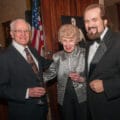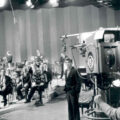Aug 9, 2016
Open Sesame
Do you remember the first time you encountered that phrase? Perhaps you saw it in an English translation of Antoine Galland’s Les Mille et une nuits (One Thousand and One Nights. . .the story of Ali Baba and the Forty Thieves). In that case, you might have pronounced it: ‘Open See-same.’
Or perhaps you – like I – just heard some childhood friend say with a magical voice: ‘Open Ses-ah-mee!”
As much fun as it might be to remember our first experiences with this phrase – still very much a part of English colloquial speech – it is a saying I find myself wanting to use whenever we present Fall in Love with Music, our basic listening course.
But open what? Open one’s mind, of course. And so it was a pleasure to read Michael Barrett’s article in Prelude, Fugue & Riffs (News for Friends of Leonard Bernstein Spring/Summer 2016) entitled: High-brow, Low-brow, All-brow Bernstein, Gershwin, Ellington, and the Richness of American Music .
Erasing the imaginary boundaries between the genres of music – classical, jazz, pop, Broadway, world, etc. – was a personal mission of Maestro Bernstein, and Michael Barrett credits Maestro Bernstein with helping him to shed those boundaries – the artificial genre borders sometimes actually taught as “Gospel Truth’ to those of us who attended music schools and conservatories in the 20th century.
The importance of developing and maintaining an open mind is an integral concept of Fall in Love with Music. In fact, Episode 3 (“Is This Music?” ) of our new 8-part series by the same name, takes up this very topic.
Composers, whether they might be Mozart or John Lennon, have very open minds. It is this quality of their personalities that allows them to notice things they like and admire in another composer’s music, and then permits them to restate those things in their own musical vocabularies. This personality trait is what also gives them the ability to reshape their own ideas in a myriad of ways.
For listeners, it is essential to bring the same degree of open-mindedness to the listening process that composers bring to the composing process. When someone says: “I know what music I like. . .and I know what music I don’t like” . . .I worry. I wonder: “With such a closed-minded attitude, have they really noticed all the wonderful details in the music they think they like?”
One of the composers lauded in Michael Barrett’s article is Duke Ellington. If you’d like to spend 12 minutes with the great pianist – recorded live at a performance in France in 1966 – view this YouTube performance.
And by the way, Michael Barrett spends plenty of time helping people to understand and appreciate music as the conductor for Jamie Bernstein’s educational concerts. I wrote a bit about this before in my 2013 blog The Bernstein Legacy.
You just never know. If we take the time to become perceptive listeners, noticing detail in music with an open mind. . .we may find ourselves getting goose bumps from an exceptionally cleverly written 30-second television or radio commercial jingle!









